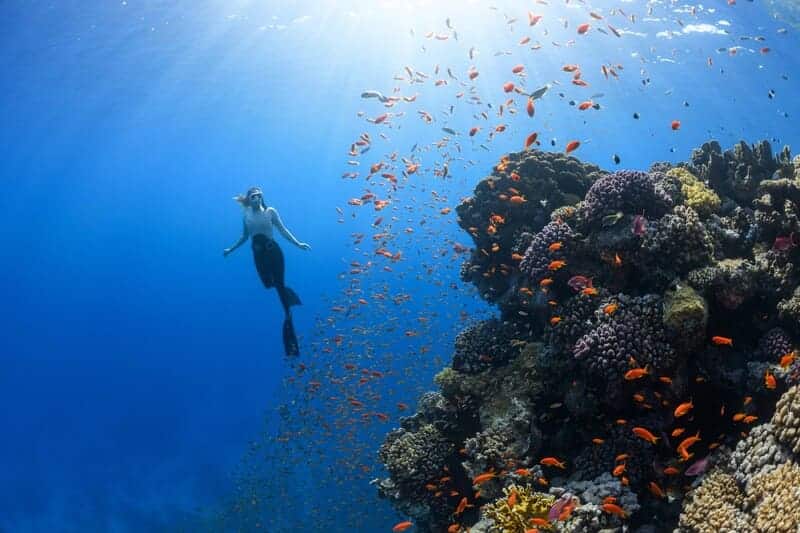Among the most vital and diverse ecosystems on the planet, coral reefs are being severely threatened by climate change, pollution, and human activities. You may have heard of the terms coral bleaching, ocean acidification, and habitat destruction; these are the leading causes of decreasing coral health all over the planet. This article will go over everything you need to know about marine conservation and coral reef restoration.
Why Coral Reef Restoration Is Important
When people think of coral reefs, they think of beautiful underwater landforms. While they are indeed beautiful, coral reefs have several much more important roles. They support about 25% of all marine species, offer protection to coastlines, and provide food and tourism opportunities for more than 500 million people.
The continued loss of coral reefs due to climate change is significant; coral reef restoration is now considered crucial for the survival and health of these marine environments. Even if humans lessen global emissions, the warming of our planet is already set in motion and will continue to threaten coral reefs for decades, making marine conservation more urgent than ever.
Understanding Reef Restoration
There are several types of reef restoration methods, all of which involve strategies to help coral reefs recover from damage. There are passive and active coral restoration methods. Passive measures involve processes like the establishment of Marine Protected Areas. Active measures involve coral gardening and coral aquaculture, both of which directly address coral health by increasing coral coverage and enhancing biodiversity.
Key Marine Conservation Methods For Coral Reefs

Coral gardening is exactly what it sounds like. Fragments of corals are collected from reefs and regrown in nurseries. Once they’re grown enough, they’re transplanted back onto the reef. These nurseries can be found on land or as floating structures in the ocean. Now, you may be wondering, how are the coral fragments attached back onto the reef?
They’re attached using various methods like cement or zip ties; however, people involved in reef restoration are also using a more recent device created with marine conservation in mind. Known as the CoralClip®, the stainless-steel spring clip clamps the coral to the reef, allowing it to grow onto the substrate securely without the need for chemical bonding agents. Once established, these corals can grow, reproduce, and help restore damaged sections of a reef.
Another common technique used in marine conservation is coral IVF, which involves collecting coral sperm and eggs during mass spawning events. They’re fertilized in controlled environments so they can produce millions of coral larvae. These larvae are then introduced into damaged reefs with the goal of repopulating dying areas with young corals that’re stronger and can establish breeding populations. This process promotes natural recovery over time.
Supporting Reefs with Structural and Biological Restoration
In some cases, reef restoration requires more than just planting some coral here and there. Structural restoration, another common technique in marine conservation, is sometimes needed; this process focuses on providing stable surfaces to which corals to attach themselves. This is especially required in areas that have been reduced to rubble from destructive activities like blast fishing or boat groundings.
Artificial structures like concrete or limestone are used to create stable foundations that enable coral settlement and growth. Biological restoration, which involves collecting and rehabilitating broken coral fragments or transplanting entire coral colonies, pairs wells with structural restoration because it allows coral to take off once established.
Wrapping Up
Coral reef restoration is crucial for marine conservation. Through techniques like coral gardening, larval reseeding, and structural restoration, scientists and conservationists are helping to rebuild these essential marine environments. For more information on coral reef restoration, check out the Coral Restoration Foundation. They offer great information on coral reef restoration, including nurseries, research, and even different ways you can get involved.
For More Great Content
Are you desiring top-tier content that covers everything? From thrilling sports and intoxicating entertainment news to gaming tips and professional betting advice, Total Apex covers it all. Delve into our no-fluff articles to stay ahead of the game with the latest sports action, uncover the hottest trends in entertainment, and get the latest scoops in the gaming industry that will take your experiences to the next level.
Finally, our betting advice will give you a decisive edge over the competition and increase your odds of beating the books. Whether you’re looking to stay updated or gain a competitive edge, Total Apex is your one-stop shop for all things compelling and relevant. Don’t forget we cover Fantasy Sports, too!
Check out all our sites: Total Apex Sports, Total Apex Fantasy Sports, Total Apex Entertainment, Total Apex Sports Bets, and Total Apex Gaming. Out of the ashes of obscurity will rise a beast. Always remember to Respect The Hustle! Follow us on Twitter/X @TotalApexSports to stay informed.









